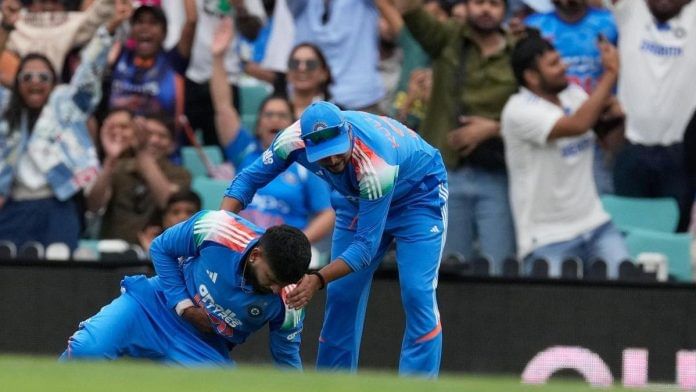New Delhi: Team India ODI vice-captain Shreyas Iyer is recovering well after he was shifted from the ICU in Sydney. Iyer, 30, suffered internal bleeding just below the rib cage while attempting the catch that dismissed Australia’s Alex Carey in the third ODI. The horrific rib-cage injury could have been fatal—had the on-ground medical team not responded swiftly to the emergency.
Iyer landed awkwardly on his left lower abdomen, immediately doubling over in pain. He then limped out of the field, grimacing, and was admitted to a hospital on Saturday.
According to reports, the middle-order batsman had severely low blood pressure, and his condition worsened in the dressing room. The BCCI on Monday confirmed Iyer’s life-threatening injury and released a statement on the matter.
“Scans have revealed a laceration injury to the spleen. He is under treatment, medically stable, and recovering well. The BCCI Medical Team, in consultation with specialists in Sydney and India, is closely monitoring his injury status. The Indian Team Doctor will remain in Sydney with Shreyas to evaluate his day-to-day progress,” the statement said.
What is a spleen laceration?
The spleen is a fist-sized organ in the upper left abdomen, located behind the ribs and above the stomach. One of the most delicate organs, it acts as a blood filter, supports the immune system, helps prevent infection, and stores blood.
A ruptured spleen is typically caused by a blow to the left upper stomach or the left lower chest, especially in car accidents and injuries in contact sports such as football, hockey, and rugby. Other causes involve fistfights and gunshot wounds.
The spleen can also rupture when it becomes enlarged due to accumulated blood cells. Various underlying problems—such as mononucleosis and other infections, liver disease, and blood cancer—can cause an enlarged spleen.
Also read: The chemistry behind carbide guns and why they are blinding children in Madhya Pradesh
Is the injury life-threatening?
According to a study, a spleen injury can be life-threatening due to the severe internal bleeding involved.
“Splenic rupture predominantly affects male individuals, with a 2:1 ratio, most commonly between the ages of 18 and 34. The spleen is a highly vascular organ, making it particularly susceptible to hemorrhage following vascular disruption,” read the document.
A ruptured spleen can be classified in five grades, with higher-grade injuries often requiring surgical management while lower–grade ones may be managed conservatively in stable patients.
While a simple, acute traumatic rupture has a mortality rate of approximately 1 per cent due to prompt treatment, the rate increases dramatically with delayed diagnosis, reaching up to 10 per cent or more. However, non-traumatic, spontaneous ruptures have a higher estimated mortality rate of around 12 per cent.
Also read: What is cloud seeding? Does it really work?
Treatment
The treatment depends on how severe the injury is. Not all ruptures or lacerations require surgery. In the case of minor injuries or tears, the internal bleeding stops on its own. Other injuries may require several types of emergency repairs.
The most common treatments for a ruptured spleen are embolisation, splenorrhaphy, and splenectomy.
Embolisation refers to a minimally invasive medical procedure that blocks a blood vessel to stop or reduce blood flow. Splenorrhaphy involves a surgical repair of the spleen to stop bleeding and fix tears. In a splenectomy, the spleen itself is removed.
(Edited by Prasanna Bachchhav)






